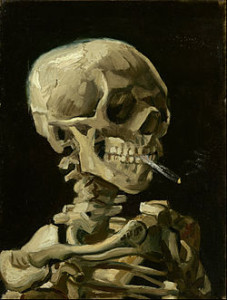By Lida Prypchan
 Followed by controversy, Vincent van Gogh’s time in Paris with his brother in 1886, Theo, was preceded by a stay in Antwerp. After being accused of improper behavior with a village woman in Nuenen, van Gogh headed to Antwerp and made an effort to study art formally – specifically the study of color theory.
Followed by controversy, Vincent van Gogh’s time in Paris with his brother in 1886, Theo, was preceded by a stay in Antwerp. After being accused of improper behavior with a village woman in Nuenen, van Gogh headed to Antwerp and made an effort to study art formally – specifically the study of color theory.
Although one may assume that it was this study period that welcomed Vincent into the world of colorful paintings, especially given his subsequent fondness for the Japanese ukiyo-e woodblock prints, and this may ultimately be the case. However, Vincent’s work in Antwerp, his school work, appeared to be irreverent and dark.
One of the most well-known works van Gogh painted during his stay in Antwerp is titled Skull of a Skeleton with Burning Cigarette. This particular oil-on-canvas painting appears to be not only fed by Vincent’s penchant for dark, somber colors, the subject matter is, at least on the surface, just as morose as the rest of his work to date. But what was an artist without human subjects to do?
In the academic setting, the introduction to live models consists of a study of skeletons. Skeletons serve to give students an understanding of human anatomy. Van Gogh’s Skull of a Skeleton with Burning Cigarette depicts a skull with a lit cigarette dangling from its teeth. Although this particular work would serve well for what we now know as anti-smoking campaigns, Vincent loved his tobacco and did not likely intend the painting as such.
The reality is that Vincent van Gogh was a very poor student. Not that he didn’t want to learn – he certainly did. Vincent simply did a very poor job of learning what others tried to teach him, especially if the teaching was more academic than practical. Vincent believed that art, and the study of art, should be a practical experience with a focus on the areas that one found needed to be studied. Unfortunately, the structured academic environment at the art academy did not conform to Vincent’s personal view of art instruction.
Vincent considered his art classes “damned boring.” And, as such, he was not only a student who often engaged in open conflict with his instructors, he let his work reflect his views of his experiences. Other work completed by Vincent while he was at the art academy includes further examples of what is called Vincent’s “studio humor.”
Vincent’s Hanging Skeleton and Cat – a study of two conflicting subjects in one piece – and his, simply titled, Skull – a painting that incorporated an unusual use of yellow – are said to have been Vincent’s own personal study of human mortality.
The Skulls series have been much debated amongst Vincent’s work. Certainly it is easy to look at these paintings and see “typical” Vincent – morose, macabre, and dark. However, these works are said to be more humorous than anything else. Experts agree that, during this period of academic exploration (which, by the way, didn’t last any longer than Vincent’s other forays into academia), Vincent wasn’t making statements about life, and more importantly, death – he was merely thumbing his nose at the uptight establishment that tried to force him to work in a way that he didn’t believe reflected his own personal style.
